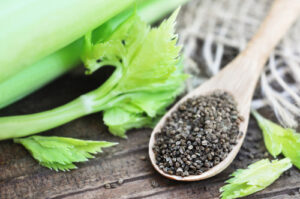Celery is a polarizing vegetable. Some of us can barely swallow its stringy texture or tolerate its unique flavor while others will willingly dip it in peanut butter to add protein and saltiness to an already healthy snack. Here’s something you should know: celery has more health benefits than a fad diet or an occasional snack.
Every part of the celery plant, from the seeds to the leaves to the stalk, contains health benefits that you can easily get just by shopping for celery at any grocery store (make sure it’s organic!). Not only does the plant consist mostly of water, which hydrates you for some basic benefits, but the remainder is a combination of vitamins that make celery a must-have in any refrigerator.
1. Celery Improves Digestion

There have been some rumors in the diet community that celery is a “negative calorie” food. Let me explain what this means. It means that theoretically, since it’s mostly water, celery may require more calories to eat than you gain from it. This is one factor that has made it a superstar in many fad diets.
But I’m all about evidence. I’m more interested in celery’s ability to improve digestion than the possibility that it could burn 5 calories through chewing. Celery is made of mostly indigestible fiber, which jumpstarts your gut and helps you have regular bowel movements.
Being high in water and a compound called apiuman also speeds up digestion and can prevent ulcers. All these things can lead to more effective weight loss and appetite control than the possibility of being a “negative calorie” food, as the fads call it.
2. Celery is Full of Flavonoids

Despite being mostly water, celery contains a ton of flavonoids, which have a variety of functions in our bodies. The ones that celery can give you include beta-carotene, zeaxanthin, and lutein.
I don’t have space here to go into specifics, but these flavonoids contain a host of health benefits. They go a long way to reducing inflammation, lowering your risk for chronic diseases, improving vision, enhancing immune function, and even preventing the growth of cancer cells.
3. Celery Can Fight Inflammation

I’ll take one of those benefits and run with it: celery’s flavonoid combination acts as an antioxidant to help fight inflammation. This is especially good news for people with rheumatoid arthritis and other auto-immune conditions.
If you experience joint pain related to a chronic disease, you’ll be happy to know that celery has been shown to help manage daily arthritis symptoms using its unique blend of minerals and flavonoids.
4. Celery Comes in Three Parts

So far, I’ve only talked about the fibrous stalk that most of us are used to eating. But celery’s leaves and seeds come with their own benefits.
The leaves, for instance, are packed with Vitamin C, potassium, and calcium. They contain a class of oils called “volatile oils” that have been shown to lower blood pressure and cholesterol.
Then there’s the seeds, which taste great in sandwiches and can be used as a spice in a lot of preparations. They come with their own health benefits, which include relieving pain from urinary tract infections, reducing muscle spasms and inflammation, and regulating blood pressure.
The Takeaway
Celery all by itself is an interesting three-part superfood that comes packed with benefits. The biggest of these is aiding with digestion: as a source of fiber, celery is indispensable for people experiencing bowel irregularity.
More than that, celery is packed with water, flavonoids, and other compounds that fight inflammation and lower blood pressure.
Kids and parents alike might enjoy celery as a snack (or hate it!), but anyone can appreciate it as a spice, chopped up in soups or stews, or as a topping. Depending on your tastes, celery might be one of the best (and yummiest) digestion-boosters around.





Leave A Comment